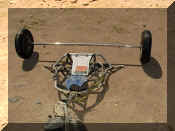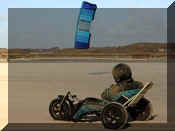 |
The backrest is made from a plastic chopping board from the
local supermarket. This pic shows the original whole chopping board;
the pic below shows it after it has been cut down to a more useful size
with a hacksaw. I drilled holes at the base, making them longer by
'waggling' the drill bit about, and on both sides near the top. A
length of 25mm webbing is tied off on one side rail. It is then fed
up, through one of the side slots near the top of the board, across the
back of the board then back through the other slot and down to the other
side rail. |
 |
A piece of 25mm webbing is looped through each of the slots
at the base, leaving enough slack so that they can be slid along the back
bar. This pic shows the backrest folded down and the 2 loops around
the back bar can be seen clearly. |
 |
I used the pieces of pipe foam to hold the backrest up and
make it easier to get into the buggy. They got in the way when I
needed to fold the rest down to transport the buggy, so I took them off
and made the loops around the frame tighter so the rest stays up on its
own. |
 |
I found that when leaning against the back rest, the webbing
tied to the side rails was pulling on the seat webbing straps and was
starting to damage the seat stitching. I put another piece of
webbing (green) from the loop around the side rail, around the front fork
(via a piece of yellow rope) and back to the loop on the other side
rail. By tensioning the green webbing, I can now adjust the angle of
the backrest. |
 |
This is it in use, before it was cut down to the smaller
size seen above. |




